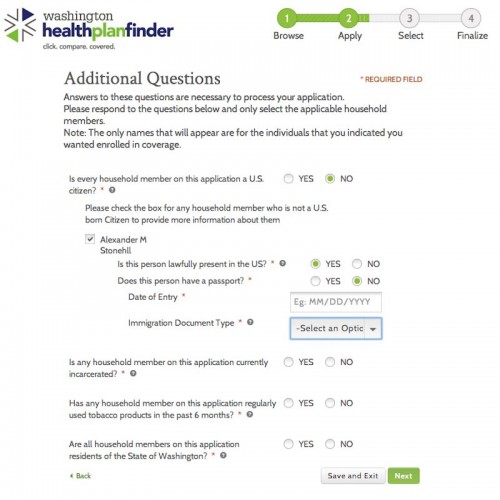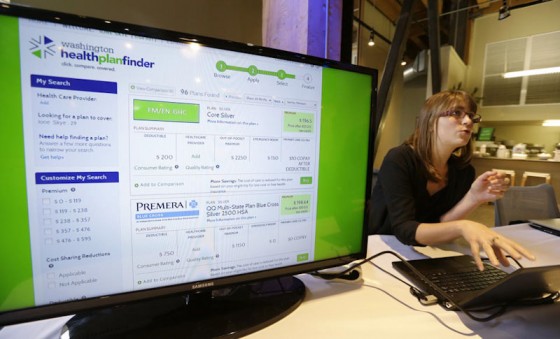Local organizations like Sea Mar and Global to Local are hoping to seize on a ‘once in a lifetime’ opportunity to get immigrants and refugees insured.
Amid plenty of national fretting about the bugs plaguing healthcare.gov, our own state insurance exchange website has seen some of the highest enrollment rates nationwide. Sign-ups on the Washington Healthplanfinder topped 175,000 through October and November.
But two and a half months after the website’s launch, healthcare providers and enrollees are still finding plenty of problems — especially when it comes to serving immigrant and refugee communities.
At a city council meeting in October, Jerry DeGrieck, a policy advisor to outgoing Mayor Mike McGinn called the Affordable Care Act enrollment period “a unique, once-in-a-lifetime opportunity” to address regional disparities in access to health care that leave as many as 30% of South King County residents uninsured.
International Community Health Services (ICHS) Sea Mar, and Global To Local(G2L) are just three of 23 local organizations trying to seize that opportunity. They’re part of a partner network that aims to serve immigrant, refugee, and homeless populations through educational outreach programs, enrollment events, and most notably, in-person assisters: trained individuals who sit down with clients and walk them through the application.
The goal is to reach the populations that an imperfect Health Plan Finder website could impact the most.
“Many of our clients are refugees and immigrants and 60 percent of them have limited English proficiency,” ICHS health-services director Michael McKee told the Seattle Times in September.
Sea Mar, a community-based organization serving ten counties statewide, hosts a number of in-person assisters who work to help individuals register for care, often through the Healthplanfinder. Managed Care Operations Director Rudy Vasquez noted that spreading awareness and dispelling myths is going to be a critical component.
“We are hearing from some communities that immigrants are afraid to come in, because from what they understand, they aren’t eligible for anything,” Vasquez said.
In fact, undocumented immigrants are the only ones fully excluded from purchasing health insurance on the exchange, though legal immigrants who are here temporarily or who have been in the country for less than five years still don’t qualify for the much-touted expansion of Medicaid benefits.
“There are myths and misinformation in these communities that we need to somehow break down so they can understand that they can still come to community health centers regardless, and can check if care programs are available for them,” Vasquez said.
I decided to take the Washington Healthplanfinder website for a spin myself to see how well it might work for a Farsi-speaking immigrant looking to purchase insurance. After a quick brush with washingtonhealthplanfinder.org, an unrelated, for-profit health plan aggregator, I made it over to the actual, official state health care exchange website, wahealthplanfinder.org.
I quickly discovered that the website is only offered in English and Spanish. A message at the bottom of the page instructs those in need of other language services to call a customer support number. When I called the number I got an automated message, in English, telling me to call back another time due to high call volume.
Such language barriers make in-person assisters like those provided by ICHS, SeaMar and G2L crucial for many local populations. G2L Connection Desk Program Manager Annya Pintak noted how the technical glitches and error codes in-person assisters encounter are impacting G2L’s immigrant and refugee clients.
“A lot of the error codes are [encountered] in applications of immigrant and refugee communities,” Pintak said. “What I’m noticing is that a lot of it is tied to immigration questions [referring to] the Alien Number, naturalization number, and date of entry. A lot of consumers are unsure or confused about this information.”

Those questions are probably intended to establish the applicant’s eligibility for various aspects of the program.
But it’s easy to see how they might inadvertently scare off people who are eligible, but nervous about filling in detailed information about their, or their family members’ immigration status on a government website.
“The effectiveness you have in these communities, especially immigrant communities, is in credibility and trust,” Vasquez said, emphasizing the important role of in-person assisters in convincing clients to complete the forms.
Often, registration entails covering not just individuals, but multiple members of extended families. This makes ensuring accuracy and avoiding error codes even trickier.
“I can’t even tell you what an average family is like in South King County because we are so diverse,” Pintak said. “We aren’t just talking about mom, dad, and one child, we are talking about mixed households with bigger families. There isn’t an average immigrant refugee family; every family is different.”
And with in-person assisters being constantly shut out of the website, as they were for several days already this month, the stress is on to meet the December 23rd deadline, the last day to register for coverage starting in 2014, and the March 31 deadline, which is the final date for enrollment in the insurance exchanges, after which the uninsured will face penalties.
“It leaves us a little less time to work in those communities who are not necessarily fluent in English and who do not understand the process,” Vasquez said. “Our approach is to try to do it online, and if for some reason we get kicked off, we immediately go to paper, because if its constantly kicking you off, you are delaying the process and it’s impacting the credibility in our relationship with consumers.”
My own attempts to register, as an American-born citizen, eventually ended in failure. Partway through the registration process I got an error message on a page that I wasn’t ever able to get past. When I went back to log in again last week, the site was down.
So when it comes down to it, no matter who you are, there is decent chance you’ll hit some bumps on your path to buying insurance on the new exchange. But to the folks at Sea Mar, G2L, ICHS, and other organizations, it’s a battle worth fighting.
“[Sea Mar] provided service to 53,000 people with no insurance coverage [in 2012], and it makes me wonder why there were that many individuals without coverage,” Vasquez said. “How did that impact continuity of care? How many people were holding off on taking their medication because they couldn’t afford it? And how much damage or cost was passed into the system by them ending up in the ER or the hospital? While I don’t have data on how [healthcare reform] can change that, it can only improve it.”
Pintak and Vasquez both note that with every new system, there are always some setbacks before things fall into place and start running smoothly. Vasquez’s current goal is to focus on the impending timeline to meet the Jan. 1 and March 31 deadlines.
“There is nothing [majorly] wrong with the Affordable Care Act — what’s wrong is the current technological implementation,” Vasquez said. “The reality is if you think we can go back to an old system, its not there anymore, it’s gone. We are going through a period where the infrastructure is not perfect and it’s not going to function well for a few months… Let’s get past that and focus on getting as many people enrolled.”
And, he believes that within a year’s time, the Healthplanfinder site will be much more refined, and its impact will be evident and revolutionary.
“When I look at a system that will theoretically allow you to walk in uninsured, and go to a kiosk and get approved for coverage in 20-30 minutes, and then walk over and make an appointment and receive care — that’s amazing, that’s the vision we need to hold on to.” Vasquez said. “You have to keep that vision in front of you.”


